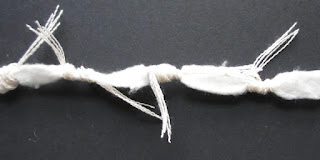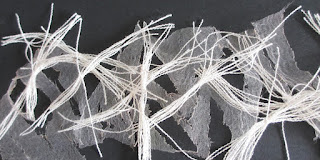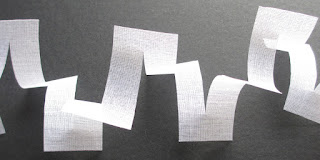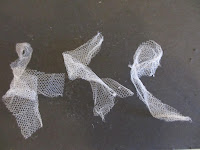So there's much to take forward from Fabric Investigation 1. What I wanted to do was marry up the technical properties of the fabrics with my six months of field gazing. In other words I wanted to interpret my observations through this process.
Amongst my fabric collection was a metre of grey beige nettle linen handwoven in Lithuania. When it arrived there was a fairly heady smell of countyside, so I laundered it immediately. The washing machine was not completely happy, but when the fabric edge dried it was wonderfully tufted (4:12) Not only that, but it also seemed to share the same DNA as my final woven piece in Ever Deeper Rabbit Holes. I pulled out some threads, then knotted clumps together, finally doing the same on the other side of the strip and twisting it, thus making a series of three, and then one more.
Ragged and Rhythmic
 |
| 4:12 |
 |
4:13
|
 |
| 4:14 |
Then what about drawing threads and with the withdrawn threads loop them through the fringe as in 4:12 Surprisingly all these images are made in the same fabric, it is the difference in light and background which create the range of tones.
 |
| 4:15 |
Below are yet more samples in a range of other fabrics. This edge making process has become a conversation between the suggestions in the module, the fabrics I'd chosen and my images, memories and descriptions of my field.
Growth and Disintegration
In the set of edges below I've used scoured cotton, pulling out most of the weft and leaving differing heights of warp above and below. These strands are photographed just as they fell.
 |
| 4:16 |
Below in 4:17 the warps have been straightened, then randomly chopped at angles. The reverse is shown in 4:18.
 |
| 4:17 |
 |
| 4:18 |
Finally Image 4:17 has been loosely rippled.
 |
| 4:19 |
I began this set with a very long strip of scoured cotton and these small bundles of warps are the leftovers. I grouped them together very loosely, tied and tossed down randomly in a line.
 |
| 4:20 |
Imprints and Remnants
The following three edges have been achieved with a soldering iron.
 |
4:21
|
Firstly, burning an imprint on wool, rather like the clumps of grass, dandelions and thistles.
 |
| 4:22 |
 |
| 4:23 |
The two images above are worked on chiffon: randomly cut shapes worked on with the point of the soldering iron to distress the edges and make holes in the centre, curling up and overlapping each other. Image 4:23 shows a strip of chiffon which has been slashed on both sides with the soldering iron.
Sinuous and Spiky
Now for a series of samples where I've been thinking about stems, stalks, blades, leaves and thorns.
 |
4:24
Interfacing with Surgeons Knots |
 |
4:25
Polyester with Net |
 |
4:26
Rolled Interfacing wrapped with bundles of
Cotton Thread, knotted and tied |
 |
4:27
Torn Strip of Polyester tied with Silk Triangles |
Now how about layering two edges? Here's an example:
 |
4:28
Clumps and Chiffon
|
Now for a couple of Cotton Organdie samples, though nicely rhythmic, I feel they're a little too stiff.
 |
| 4:29 |
 |
| 4:30 |
Wrapped and Twined
Following on from 4:29 and 4:30 are a further three ideas, exploring other things I've noticed in the field. 4:31 is inspired by the way convolvulus twists and wraps itself round the stems of other plants. Fine silk has been stitched round garden wire and wrapped round a pencil and stretched in places before a length of scoured cotton is threaded through the loops.
 |
| 4:31 |
The final two samples take up the idea of plastic wrapped around the trunks of hedge plants and how they spring off and out and away as the trunks grow. I was imagining a row of these, though possibly a little more tightly wound. I thought the net might allow something to show if pushed through the middle. On reflection though, it is less easy to control than the cotton organdie.
 |
| 4:32 |
 |
| 4:33 |
Coming to the end of these samples I realise I've interpreted what is an "edge" quite liberally and this may be something to do with the way the field has infiltrated my mind. The nettle samples are literally on the edge, but others may well need to be appliqued to a background fabric or possibly threaded through. Of these, the samples which are particularly dimensional might be flattened somewhat in the process, losing that "alive" and spontaneous feel. Attaching "edges" to a piece of work would appear to be another problem-solving activity! What I do like particularly about these samples though, is the rhythm and repetition within them without their elements being exact repeats.
Reflecting on the first sentence I wrote on this post about trying to marry up the technical properties of my fabric collection with the inspirations I've drawn from my field, I would say there is much more to be explored. Though I've tried to make the right selections for the samples above they really are only experiments, hopefully after further experience my selections will be more sure-footed.










































